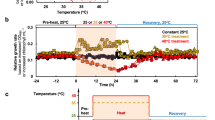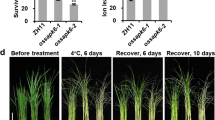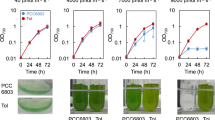Abstract
THE sensitivity (or tolerance) of plants to chilling determines their choice of natural habitat and also limits the worldwide production of crops. Although the molecular mechanism for chilling sensitivity has long been debated, no definitive conclusion has so far been reached about its nature. A probable hypothesis1,2, however, is that chilling injury is initiated by phase transition of lipids of cellular membranes, as demonstrated for cyanobacteria, which serve as a model system for the plant cells3,4. Because the phase transition temperature depends on the degree of unsaturation of fatty acids of the membrane lipids5, it is predicted that the chilling tolerance of plants can be altered by genetically manipulating fatty-acid desaturation by introducing double bonds into fatty acids of membrane lipids. Here we report the cloning of a gene for the plant-type desaturation (termed desA). The introduction of this gene from a chilling-resistant cyanobacterium, Synecho-cystis PCC6803, into a chilling-sensitive cyanobacterium, Anacystis nidulans, increases the tolerance of the recipient to low temperature.
This is a preview of subscription content, access via your institution
Access options
Subscribe to this journal
Receive 51 print issues and online access
$199.00 per year
only $3.90 per issue
Buy this article
- Purchase on Springer Link
- Instant access to full article PDF
Prices may be subject to local taxes which are calculated during checkout
Similar content being viewed by others
References
Lyons, J. M. A. Rev. Pl. Physiol. 24, 445–466 (1973).
Raison, J. K. J. Bioenergetics 4, 285–309 (1973).
Murata, N. & Nishida, I. The Biochemistry of Plants Vol. 9 (Academic, Orlando, 1987).
Murata, N. J. Bioenergetics Biomembranes 21, 61–75 (1989).
Chapman, D. Q. Rev. Biophys. 8, 185–235 (1975).
Wada, H. & Murata, N. Pl. Cell Physiol., Tokyo 30, 971–978 (1989).
Dzelzkalns, V. A. & Bogorad, L. EMBO J. 7, 333–338 (1988).
Williams, J. G. K. Meth. Enzym. 167, 766–778 (1988).
Thiede, M. A. et al. J. biol. Chem. 261, 13230–13235 (1986).
Kuhlemeier, C. J. & van Arkel, G. A. Meth. Enzym. 153, 199–215 (1987).
Kenyon, C. N. J. Bacteriol. 109, 827–834 (1972).
Kenyon, C. N. et al. Arch. Mikrobiol. 83, 216–236 (1972).
Ono, T. & Murata, N. Pl. Physiol. 67, 176–181 (1981).
Omata, T. & Murata, N. Pl. Cell Physiol., Tokyo 24, 1101–1112 (1983).
Gombos, Z. & Vigh, L. Pl. Physiol. 80, 415–419 (1986).
Beck, E. et al. Gene 19, 327–336 (1982).
Sato, N. & Murata, N. Meth. Enzym. 167, 251–259 (1988).
Tabor, S. & Richardson, C. C. Proc. natn. Acad. Sci. U.S.A. 84, 4767–4771 (1987).
Kyte, J. & Doolittle, R. F. J. molec. Biol. 157, 105–132 (1982).
Author information
Authors and Affiliations
Rights and permissions
About this article
Cite this article
Wada, H., Combos, Z. & Murata, N. Enhancement of chilling tolerance of a cyanobacterium by genetic manipulation of fatty acid desaturation. Nature 347, 200–203 (1990). https://doi.org/10.1038/347200a0
Received:
Accepted:
Issue Date:
DOI: https://doi.org/10.1038/347200a0
This article is cited by
-
David (Dave) Charles Fork (1929–2020): a gentle human being, a great experimenter, and a passionate researcher
Photosynthesis Research (2023)
-
Engineering the fatty acid synthesis pathway in Synechococcus elongatus PCC 7942 improves omega-3 fatty acid production
Biotechnology for Biofuels (2018)
-
Cyanophage-encoded lipid desaturases: oceanic distribution, diversity and function
The ISME Journal (2018)
-
Productivity and biochemical composition of Tetradesmus obliquus and Phaeodactylum tricornutum: effects of different cultivation approaches
Journal of Applied Phycology (2016)
-
Identification and characterization of a novel bifunctional Δ12/Δ15-fatty acid desaturase gene from Rhodosporidium kratochvilovae
Biotechnology Letters (2016)
Comments
By submitting a comment you agree to abide by our Terms and Community Guidelines. If you find something abusive or that does not comply with our terms or guidelines please flag it as inappropriate.



